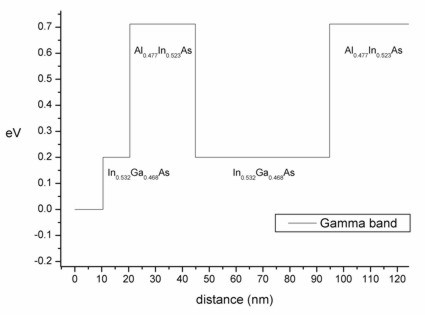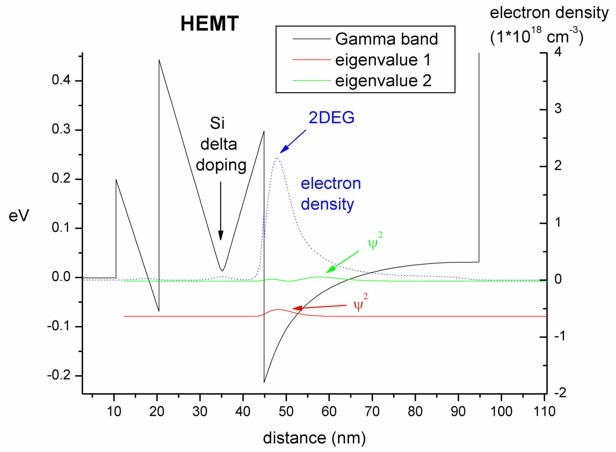HEMT structure (High Electron Mobility Transistor)¶
- Input files:
HEMT_1D_nnp.in
HEMT_2D_nnp.in
HEMT_3D_nnp.in
- Scope:
This tutorial demonstrates how High Electron Mobility Transistors can be modelled with nextnano++.
HEMT structure¶
Input file: HEMT_1D_nnp.in
The structure consists of the following material layers:
width [nm] |
material |
|
1 |
Schottky barrier 0.2 eV |
|
2 |
10.0 |
\(In_{0.532}Ga_{0.468}As\) |
3 |
25.0 |
\(Al_{0.477}In_{0.523}As\) |
4 |
50.0 |
\(In_{0.532}Ga_{0.468}As\) |
5 |
300.0 |
\(Al_{0.477}In_{0.523}As\) |
6 |
300.0 |
InP |
The conduction band edge profile without doping is plotted in Figure 2.4.15.1.

Figure 2.4.15.1 Calculated conduction band edge profile.¶
Now we add at x = 35 nm a silicon delta doping of 4.5 \(\cdot\) 1012 cm-2 which leads to band bending. Instead of choosing a delta doping we specify a constant doping of 1.5 \(\cdot\) 1020 cm-3 that extends over 0.3 nm. (1.5 \(\cdot\) 1020 cm-3 \(\cdot\) 3 \(\cdot\) 10-8 cm = 4.5 \(\cdot\) 1012 cm-2)
We obtain two eigenstates and their corresponding wave functions inside the HEMT channel which leads to a two-dimensional electron gas (2DEG), see Figure 2.4.15.2. The electron density is plotted in blue.

Figure 2.4.15.2 Calculated conduction band edge profile and probability densities.¶
In the file bias_00000/total_charges.txt we can find the integrated electron and hole densities. The total integrated density (from 10 nm to 100 nm) which can be measured experimentally is 1.87 \(\cdot\) 1012 cm-2 in agreement with the experiment. Most of the density is located between 45 nm and 95 nm.
2D/ 3D simulations¶
Input files: HEMT_2D_nnp.in, HEMT_3D_nnp.in
Input files for the same HEMT structure as in 1D, this time for a 2D and 3D simulations, are also available.
2D: rectangle of dimension 250 nm x 10 nm
3D: cuboid of dimension 250 nm x 10 nm x 10 nm
Last update: nn/nn/nnnn